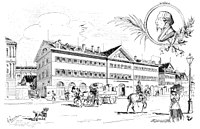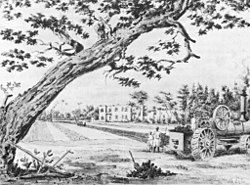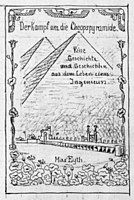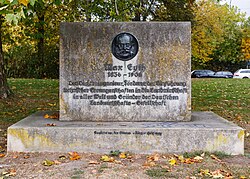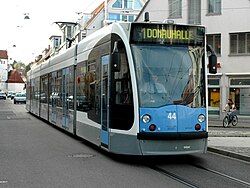Max Eyth
Eduard Friedrich Maximilian Eyth , since 1896 Max von Eyth , (born May 6, 1836 in Kirchheim unter Teck , † August 25, 1906 in Ulm ) was a German engineer, writer and draftsman.
Up to 1882, Max Eyth was on the road in three parts of the world for over 20 years, promoting steam-powered machines that were used in agriculture and cableway shipping . He contributed to the improvement of the machines through various inventions. In 1885 he founded the German Agricultural Society , which he headed until 1896.
In the last decade of his life in Ulm, most of his literary works were created, of which “Behind Plow and Vice”, “The Battle for the Great Pyramid” and “The Tailor of Ulm” were the most successful. Max Eyth was also a gifted and prolific draftsman. He left behind more than 1,000 drawings and watercolors, on which he captured impressions of almost all stages in his eventful life.
Max Eyth's inventions did not survive the age of the steam engine. His literary and graphic works, however, secured him a place in literary and art history.
Life
Early years
Max Eyth was born on May 6, 1836, the oldest of three children in Kirchheim unter Teck. His father was Eduard Eyth (1809-1884), teacher ( senior preceptor ) at the Latin school in today's Max-Eyth-Haus (ground floor), in which the family also lived (1st floor) and where Max Eyth was born. The father was also active as a writer and translator of Greek classics. His mother Julie Eyth b. Capoll (1816–1904) was a successful author of Christian aphorisms. Max Eyth's siblings were Julie Kraut verw. Conz born Eyth (1839–1896) and Eduard Wilhelm Eyth (1851–1875). The parental home was definitely “of pietistic Christianity and humanistic spirit”.
In 1841 the family moved to Schöntal , where Max Eyth's father was appointed professor of Greek and history at the Evangelical Theological Seminary and in 1865 was appointed director ( Ephorus ). In Schöntal, Max Eyth received private lessons from his father, perhaps also playing the piano, which he practiced with great enthusiasm throughout his life. He probably also enjoyed private freehand drawing lessons, which he had had since childhood. From 1848 on, Max Eyth took part as a private guest student in the classes in the ancient language-oriented seminar, where he devoted himself particularly to mathematics under the teacher Christian Zeller.
|
|
|
|
|
An experience falls into the Schöntal period
- "Where the first spark of the new fire, the spirit of our time, fell on me, soon to become a bright flame that has kept me warm through a long, difficult life".
When visiting a water-powered iron hammer (hammer forge) in Ernsbach am Kocher at the age of eight, he was gripped by a deep fascination for machines and technology that never let go of him for a lifetime. In 1852 he attended secondary school for six months in Heilbronn, where his father's parents lived, in order to prepare for studying at the Polytechnic School in Stuttgart. From 1852 to 1856 he completed a four-year course of study at this school, where he chose technical mechanics as a focus, but also attended general courses. Max Eyth's first literary works, poems, novellas, the verse tale “Volkmar” and the peasant war story “Mönch und Landsknecht” originated in Schöntal, but especially during his studies.
job
Beginnings
In November 1856, Max Eyth started his first job as an apprentice locksmith at the Hahn & Göbel machine factory in Heilbronn, but was fired after six weeks because he could not get used to the monotonous, subordinate work. His next job took him to Stuttgart-Berg , where he was employed as an apprentice at the Gotthilf Kuhn steam engine factory in January 1857 , and after a year he was employed as a draftsman and customer fitter. In 1860 his boss sent him to Paris to spy on the gas engine invented by Étienne Lenoir . The trip to Paris aroused wanderlust in him, and so he decided to go hiking in 1861:
- “Out; learning and creating by learning was my first and last thought. Everything else had to be found. "
Wandering years
In 1861 Max Eyth began his more than 20-year odyssey as a sales engineer, which took him halfway around the world. The beginning of his hike was a multi-week trip to large cities in the Ruhr area and Belgium. Here he familiarized himself with the latest technical developments, but could not find a job as a draftsman. He therefore decided to go to England, what was then the Mecca of technical development.
After several fruitless attempts to find a job as a draftsman, he met John Fowler in July 1861 at an agricultural exhibition in Manchester , who hired him in September that year in his steam plow factory John Fowler & Co. in Leeds . After a brief workshop practice and a sweaty internship in steam plowing, he soon found the opportunity to prove himself as a draftsman and designer, so that Fowler sent him to the World Exhibition in London from May to November 1862 . There he managed the stand construction, managed the company stand for half a year and looked after the international audience as a consultant.
In early 1863, Fowler sent his esteemed colleague to Egypt, where he had sold two of his steam plows. Max Eyth was to spend the next three years in Egypt. He got to know Halim Pascha , the grandson of the late governor of Egypt, who owned many lands and wanted to equip them with modern machines. As chief engineer, Max Eyth managed the use of steam plows and other agricultural machines from Schubra on the Nile Delta, for which he himself invented various improvements. He also took the opportunity to explore ancient Egypt, which he had admired since his youth. Rivalries with the Egyptian viceroy led to the economic collapse of Halim Pascha in 1866, so that he could not extend Max Eyth's three-year contract. Max Eyth therefore left Egypt in May 1866.
|
|
|
|
After his return to the old continent, Max Eyth used the time to stay in his home country and to travel and hike. After six months he set out for North America in November 1866 to introduce Fowler's steam plows and rope navigation (“ rope work ”) with Fowler's towing machines. Despite successful attempts on the Erie Canal , the authorities refused the license to install the system in practice. The introduction of the steam plow was also unsuccessful. Back in Europe, Max Eyth succeeded in Belgium in installing a cable boat system on the Maas.
From 1869 to 1882 Max Eyth worked again for Fowler in Leeds. He occupied himself with the construction of new and the improvement of existing products and organized Fowler's appearance at the annual agricultural exhibitions in England as well as at the world exhibitions in Vienna in 1873 and in Paris in 1878. Numerous trips took him again and again to Eastern Europe, America, Egypt and Russia, where he promoted Fowler's machines as a sales engineer.
At the beginning of the 1880s, a new generation took over the management of the Fowler company. Tensions with the new management led Max Eyth to leave the company after two decades in 1882 to "paddle my own canoe, as it is called in a nice English song, to row my own boat".
German Agricultural Society
Over the years, Max Eyth had amassed a sizable fortune that enabled him to live a carefree life as a reindeer. At 46, however, he felt too young to retire. He planned to establish a national society for the promotion of backward German agriculture based on the model of the Royal Agricultural Society of England . For this purpose, after his return to Germany in 1882, he settled in Bonn, which lay neutrally in the middle between northern and southern Germany. In addition, the Agricultural Academy had its seat in Poppelsdorf , then a neighboring town, today a district of Bonn.
In the beginning his efforts met with great resistance, especially on the part of the 1650 local farmers' associations. Thanks to his usual persistence, he managed to gain 2500 provisional members, including Otto von Bismarck , through intensive lobbying and press work in two years . On December 11, 1885, the founding assembly of the German Agricultural Society met in Berlin . Max Eyth not only invented the name of the company and the abbreviation DLG (today DLG), but also the logo with the ox driver who paints the abbreviation DLG in the air with his whip. He became a managing director and moved with the DLG to Berlin . The annual agricultural exhibitions at different locations were close to his heart. In 1896 the number of DLG members had grown to 11,000. Max Eyth organized another exhibition in Cannstatt and in the same year resigned from office to retire into private life.
Retirement
Max Eyth's brother Eduard Eyth (1851–1875), who had also been employed as an engineer at Fowler since 1871, died of tropical fever at the age of 24 on a business trip to Cuba. His sister Julie Kraut uses Conz born Eyth died in 1896 at the age of 57. His father Eduard Eyth had died in 1884, and his mother Julie Eyth (1816–1904) lived alone in Neu-Ulm. In 1896 the 60-year-old Max Eyth moved to his 80-year-old mother at Friedrichstrasse 19 (today Hermann-Köhl-Strasse 19). At the same time he rented an apartment in Ulm at Michelsberg 173 (today Mozartstrasse 24), in which he retired to work during the day. He only went on short trips and looked after his ailing and increasingly mentally confused mother until her death in 1904. He then bought the villa in Ulm at Michelsberg 227 (today Lichtensteinstrasse 16, → photo ). Max Eyth outlived his mother by two years. He died unmarried on August 25, 1906 in Ulm. His grave is in Section 57 of the New Cemetery in Ulm.
In his will, Max Eyth bequeathed his drawings to the Ulm Museum and decreed the establishment of a foundation endowed with 80,000 marks to support the relatives of accident victims. The Max-Eyth-Haus literature museum in Kirchheim unter Teck documents his life and work. The municipal museum in the Kornhaus Kirchheim unter Teck shows Max Eyth's furniture from his apartment in Ulm.
Literary work
Max Eyth used the last decade of his life in Ulm and Neu-Ulm for his literary work and for the organization and revision of the more than 1000 drawings he had created over the years. His literary work had already begun at the seminar in Schöntal and at the Polytechnic School in Stuttgart. During this time he wrote poems, short stories, the peasant war novel "Mönch und Landsknecht" and "Volkmar", a story that takes place in the late Middle Ages.
Autobiographical
During his son's traveling years, his father published 6 volumes in 6 volumes of his father's letters under the title "An engineer's traveling book". In 1904 and 1905 Max Eyth reissued the letters in 3 volumes under the title "Im Strom Our Time". The first two volumes "Lehrjahre" and "Wanderjahre" contain the letters from the hiking book, while the volume "Meisterjahre" covers the founding and management of the DLG. The 3 volumes are illustrated with around 100 drawings by Max Eyth.
In 1899 Max Eyth published “Behind Plow and Vice. Sketches from an engineer's paperback ”, a“ mixture of technology and adventure history, of memories and travelogues ”. It is “Max Eyth's best-known and most successful book, which was reprinted in 1940 in the 298th thousand, 1987 in the 421th thousand, with excerpts it went into many readers and was also widely distributed through separate prints of individual stories”. This 2-volume work also contained the story “Berufstragik”, which was also published separately under the title “The Bridge over the Ennobucht”. This poetic treatment of the railway accident on the Firth-of-Tay Bridge also addressed the problem of belief in technical progress.
Novels
Two other works dealt with fictional material. In the two-volume novel "The Battle of the Great Pyramid", two brothers fight a spiritual battle over the Great Pyramid. One sees the pyramid of Cheops as "a simile of the cosmic order turned into stone, which he seeks to decipher and preserve". The other wants to exploit the pyramid as a quarry for the planned construction of a gigantic dam across the Nile Delta.
The posthumously published novel “Der Schneider von Ulm. The story of someone born two hundred years too early ”, in which historical truth and fiction are interwoven, is a memorial to Albrecht Ludwig Berblinger , the hapless inventor from Ulm who made himself the mockery of his contemporaries with his attempts to fly.
Drawing work
In addition to his literary work, Max Eyth also left an extensive work of drawings. The numerous publications about his life and work deal excellently with his literary work, while his artistic work largely went unnoticed:
- “Despite these numerous publications on Max Eyth's life and work, it is hardly known that he is also a talented and very productive draftsman. He records impressions of almost all stages in his eventful life in sketchbooks, which are constant companions on his trips and trips. This results in well over 1000 mostly postcard-sized drawings and watercolors. They show landscapes, architecture and cityscapes, interesting cultural and historical information as well as representations that testify to his enthusiasm for technology. In addition, Eyth works as an illustrator; Among other things, he designs the book covers of his novels. ”(For Max Eyth's cover designs, see writings )
This is how Birgit Knolmayer describes the draftsman Max Eyth in her monograph “Max Eyth. A life in sketches. Studies on the graphic work ”, which includes a DVD with the first catalog of Max Eyth's artistic work. The three volumes of Max Eyth's autobiographical collection of letters “In the Current of Our Time” are illustrated with around 100 of his own drawings. The logo of the German Agricultural Society, which existed until 1963, was also created based on a design by Max Eyth (see German Agricultural Society ).
Honors
- 1892: Appointed Privy Councilor.
- 1896: Award of the Cross of Honor of the Order of the Württemberg Crown and elevation to the personal nobility status ("von Eyth").
- 1896: Foundation of the Max Eyth Medal by the German Agricultural Society, first award of the Medal in Gold to Max Eyth.
- 1898: Honorary membership of the RSC-Corps Agraria Bonn.
- 1905: (First) honorary doctor Dr. Ing.hc from the Technical University of Stuttgart .
- 1905: Award of the Grashof Memorial Medal by the Association of German Engineers (VDI).
- 1906: (First) honorary member of the Württemberg Journalists and Writers Association.
- 1908: Inauguration of a monument by Ernst Herter for Max Eyth in Dessauer Straße in Berlin-Kreuzberg , the then seat of the German Agricultural Society .
- 1923: Inauguration of a memorial plaque at the Max-Eyth-Haus in Kirchheim unter Teck (see picture), in 1925 Max Eyth's birthplace was named Max-Eyth-Haus.
- 1932: Founding of the Max Eyth Society for the Promotion of Agricultural Engineering. In 1970 it was transferred to the VDI department of Max-Eyth-Gesellschaft Agrartechnik (VDI-MEG).
- 1936: Name of the Max-Eyth-See in Stuttgart-Hofen on Max Eyth's 100th birthday. The pedestrian bridge leading to the lake, built in 1989, was named Max-Eyth-Steg.
- 1950: Foundation of the Max Eyth commemorative coin by the Max Eyth Society for the promotion of agricultural engineering.
- The Ulm trams bear the names of famous personalities who were related to the city of Ulm. One car bears the name of Max Eyth (see illustration), another one commemorates Albrecht Ludwig Berblinger , the unfortunate inventor from Ulm, to whom Max Eyth set a monument in his novel "The Tailor of Ulm".
- In Ulm, a memorial stone on the eagle bastion reminds of Max Eyth (see picture).
- Nationwide over 50 streets and many schools are named after Max Eyth.
- In the Haus der Wirtschaft in Stuttgart, the Eyth Hall is named after Max Eyth.
Fonts
| year | plant | genus |
|---|---|---|
| 1863 | Volkmar. Historical-romantic poem. Leipzig: Grunow, 1863. pdf , full text online in the Gutenberg project. | Narration |
| 1871.1 | An engineer's hiking book. In letters from Max Eyth, Volume 1: Europe. - Africa. and Asia. Heidelberg: Winter, 1871. | Letters |
| 1871.2 | An engineer's hiking book. In Letters from Max Eyth, Volume 2: America. Heidelberg: Winter, 1871. Internet Archive . | Letters |
| 1871.3 | An engineer's hiking book. In letters from Max Eyth, Volume 3: Novellas. Along with an appendix of poems. Heidelberg: Winter, 1871. - Contains the stories "The First Dance Shoes", "Schlehen", "The Invalide", "Madonna" and the series of poems "Charaden", "Songs on a vice" and other poems. | Novellas |
| 1876 | An engineer's hiking book. In letters from Max Eyth, Volume 4: From three parts of the world. [With contributions by his brother Eduard Eyth]. Heidelberg: Winter, 1876. | Letters |
| 1879 | An engineer's hiking book. In letters from Max Eyth, Volume 5: From near and far. Heidelberg: Winter, 1879. | Letters |
| 1884 | An engineer's hiking book. In letters from Max Eyth, Volume 6: Fremde und Heimath. Heidelberg: Winter, 1884. | Letters |
| 1878 | The forest devil. Heilbronn: Henninger, 1878. epub , full text online in the Gutenberg project. | Stage plays |
| 1882 | Monk and Landsknecht. Story from the peasant war. Heidelberg: Winter, 1882. epub , full text online in the Gutenberg project. | stories |
| 1893 | Celebration hours. Stories, drama and lyric. Heidelberg: Winter, 1893. Full text online in the Gutenberg project. - Contains the stories “The First Dance Shoes”, “The Invalid”, “Madonna”, “Monk and Landsknecht”, the comedy “Der Waldteufel”, the historical-romantic poem “Volkmar” and the poetry series “Charaden”, “Lieder am Vice ”and“ filings ”. | Miscellaneous |
| 1899 | Behind plow and vice. Sketches from an engineer's diary. 2 volumes. Stuttgart: Deutsche Verlags-Anstalt, 1899. epub , full text online in the Gutenberg project. | stories |
| 1899.2 | The bridge over the Ennobucht (occupational tragedy). In: #Eyth 1899 , pages 371-493. From 1955 separate print by Reclam. Max Eyth page , full text online in the Gutenberg project. | stories |
| 1902 | The battle for the Great Pyramid. A story and stories from the life of an engineer. Volume 1. Heidelberg: Winter, 1902. pdf , full text online in the Gutenberg project. | Novels |
| 1906 | The battle for the Great Pyramid. A story and stories from the life of an engineer. Volume 2. Heidelberg: Winter, 1906. pdf , epub . | Novels |
| 1904 | In the current of our time. From letters from an engineer. Volume 1: Years of Apprenticeship. Heidelberg: Winter, 1904. pdf , epub , full text online in the Gutenberg project. | Letters |
| 1904 | In the current of our time. From letters from an engineer. Volume 2: Years of Wandering. Heidelberg: Winter, 1904. pdf , epub , full text online in the Gutenberg project. | Letters |
| 1905 | In the current of our time. From letters from an engineer. Volume 3: Master Years. Heidelberg: Winter, 1905. pdf , epub , full text online in the Gutenberg project. | Letters |
| 1905.2 | Living forces. Seven lectures from the field of technology. Berlin: Springer, 1905. pdf . | technology |
| 1906 | The tailor from Ulm. Story of a born two hundred years premature. 2 volumes. pdf , epub , | Novels |
literature
life and work
More recent monographs on Max Eyth: #Harbusch 2006 and # Theißen 2006 .
- Georg Biedenkapp: Max Eyth, a German engineer and poet. A biographical sketch. Stuttgart: Franckh, 1910.
- Hans Binder: The engineer and poet Max Eyth (1836–1906) and his plan of the mammoth cave in Kentucky (USA) from 1866. Munich: Association of German Cave and Karst Researchers e. V., 1997. (= Treatises on Karst and Speleology, 28)
- Lili du Bois-Reymond : Max Eyth. Engineer, farmer, poet. Berlin: Wegweiser-Verlag, 1931.
- Theodor Ebner: Max Eyth, the poet and engineer. A Swabian way of life. Heidelberg: Winter, 1906, pdf . - With list of publications.
- Paul Gehring: Max Eyth. Engineer, founder of the German Agricultural Society, writer and poet, 1836–1906. In: Hermann Haering (editor); Otto Hohenstatt (editor): Swabian life pictures. Volume 3. Stuttgart: Kohlhammer, 1942, pages 156-181. - With a list of publications and references.
- Paul Gehring: Eyth, Eduard Friedrich Maximilian von. In: New German Biography (NDB). Volume 4, Duncker & Humblot, Berlin 1959, ISBN 3-428-00185-0 , p. 714 f. ( Digitized version ).
- Hans Dieter Haller: Max Eyth (1836 to 1906). In: Pegasus in the country - writers in Hohenlohe. Crailsheim: Baier, 2006, ISBN 3-929233-62-2 , pages 88-93.
- Ute Harbusch: Max Eyth: writer and engineer; with steam and imagination; (1836-1906). Kirchheim unter Teck: Städtisches Museum, 2006. - With a list of writings and references.
- Rudolf Heege: Max von Eyth. A poet and philosopher in word and deed. Berlin: German Agricultural Society, 1928 (= work of the German Agricultural Society, 356)
- Max Eyth: The independent one. In: Bärbel Kuhn : Marital status: single. Singular women and men in the bourgeoisie (1850-1914). Cologne: Böhlau, 2000, pages 216-237.
- Wolfgang Metzger: Max Eyth. The poet and pioneer of technology. Stuttgart: Calwer, 1940. (= encounters, 4)
- Viktor Pröstler: Max Eyth 1836–1906, “My life in sketches” . Ulm: Süddeutsche Verlagsgesellschaft, 1986.
- Frank Raberg : Biographical Lexicon for Ulm and Neu-Ulm 1802-2009 . Süddeutsche Verlagsgesellschaft im Jan Thorbecke Verlag, Ostfildern 2010, ISBN 978-3-7995-8040-3 , p. 96-98 .
- Adolf Reitz : Max Eyth. An engineer travels the world. Pioneering deeds of an agricultural technician. Heidelberg: Energie-Verlag, 1956. - With a list of publications and references.
- Alexander Schölch: How the “steam culture” came to the Nile: Max Eyth and Egypt . In: Die Welt des Islams , Volume 28, Issue 1, 1988, pages 513-520, preview .
- Gerd Theißen: Max Eyth - agricultural technology pioneer and poet of action. On the 100th anniversary of the death of the DLG founder. Frankfurt: MEV, 2006. - Illustrated throughout, mostly in color.
- Christiane Todrowski: Bourgeois technology "utopians". A contribution to the function of optimism for progress and technology euphoria in bourgeois thinking of the 19th century. Shown using the example of the publications Max Eyths and Max Maria von Webers. Dissertation, University of Münster 1996.
- Carl Weihe: Max Eyth. A brief view of life with extracts from his writings. 2nd Edition. Berlin: Publishing house of the Association of German Engineers, 1922.
Drawing work
- Birgit Knolmayer: Max Eyth. A life in sketches. Studies on the graphic work. Cologne: Böhlau, 2012. - With 202 black-and-white illustrations and a DVD with a catalog of the graphic work and with a list of sources, writings and literature.
- Peter Lahnstein: Max Eyth. The best from the drawing work of an experienced engineer. Stuttgart: Kohlhammer, 1987, ISBN 3-17-009407-6 . - With 61 color reproductions in original size.
- Viktor Pröstler: In: # Pröstler 1986 , pages 39–176. - With 51 color and 84 black and white illustrations.
Web links
- Literature by and about Max Eyth in the catalog of the German National Library .
- Newspaper article about Max Eyth in the press kit of the 20th century of the ZBW - Leibniz Information Center for Economics .
- Works by Max Eyth in the Gutenberg-DE project .
- Website of the German Agricultural Society for Max Eyth .
- History of the German Agricultural Society (DLG) .
- Ulm story about Max Eyth .
- Article by / about Max Eyth in the Polytechnisches Journal
- Exhibition on Max Eyth in the Stuttgarter-Zeitung.de, June 14, 2012.
Footnotes
- ↑ # Gehring 1959 .
- ↑ #Harbusch 2006 , pages 12-13.
- ↑ #Eyth 1904.1 , page 4.
- ↑ #Eyth 1904.1 , pages 3–10. - On these pages, Max Eyth describes his “awakening experience” with anecdotal embellishment and epic breadth.
- ↑ #Harbusch 2006 , pp. 14–24.
- ↑ #Harbusch 2006 , pp. 33–35.
- ↑ #Eyth 1904.1 , page 32.
- ↑ #Eyth 1904.1 , pp. 32-107.
- ↑ #Eyth 1904.1 , pp. 108–244.
- ↑ # Gehring 1942 , pp. 161–163.
- ↑ #Eyth 1904.2 .
- ↑ #Eyth 1904.2 , page 401.
- ↑ # Theißen 2006 , pages 121–149, #Harbusch 2006 , pages 59–61.
- ↑ On Max Eyt's celibacy see: #Kuhn 2000 .
- ↑ #Harbusch 2006 , pp. 65–67, 106.
- ↑ Ulmer Geschichte (n) - 100th anniversary of the death of Max Eyth ( Memento of the original from April 29, 2018 in the Internet Archive ) Info: The archive link has been inserted automatically and has not yet been checked. Please check the original and archive link according to the instructions and then remove this notice. .
- ^ Illustration of the Max Eyth room in the Kornhaus: # Pröstler 1986 , page 28.
- ↑ #Harbusch 2006 , page 76.
- ↑ #Harbusch 2006 , page 72.
- ↑ #Harbusch 2006 , pp. 72–81.
- ↑ #Harbusch 2006 , pp. 81–84.
- ↑ #Harbusch 2006 , pp. 93–97.
- ↑ #Knolmayer 2012 , page 10.
- ↑ #Knolmayer 2012 .
- ↑ #Harbusch 2006 , page 60.
- ↑ #Harbusch 2006 , page 68.
- ^ Announcements of the German Agricultural Society, issue 19, 23rd year, Berlin May 9, 1908.
- ^ City stroll in Kirchheim unter Teck .
- ↑ History of the Max Eyth Society for Agricultural Technology in the VDI .
- ↑ #Harbusch 2006 , page 107.
- ↑ Subtitle partly also: Sketches from an engineer's paperback.
| personal data | |
|---|---|
| SURNAME | Eyth, Max |
| ALTERNATIVE NAMES | Eyth, Max von (name from 1896); Eyth, Eduard Friedrich Maximilian (maiden name) |
| BRIEF DESCRIPTION | German engineer and writer |
| DATE OF BIRTH | May 6, 1836 |
| PLACE OF BIRTH | Kirchheim unter Teck |
| DATE OF DEATH | August 25, 1906 |
| Place of death | Ulm |




